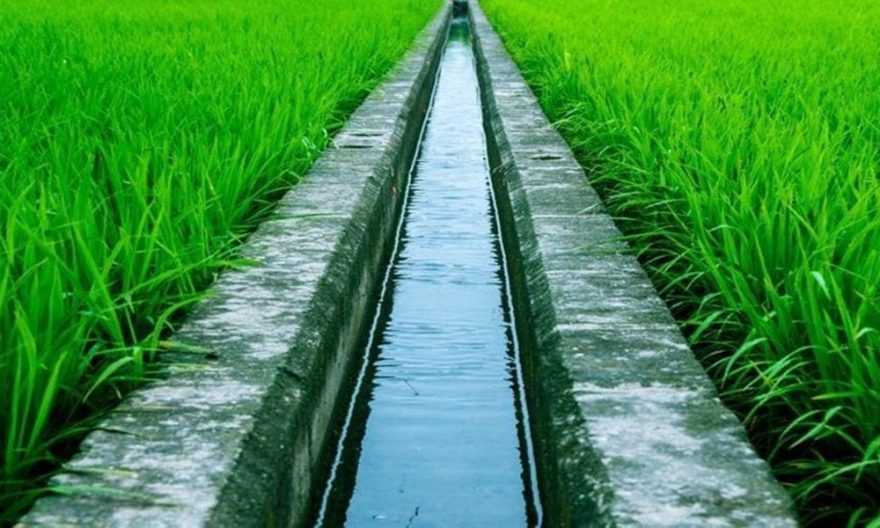
Ethiopia’s landscapes have a diverse and rich agricultural heritage. The country has long relied on irrigation farming as a crucial means of sustaining its population and driving economic growth. With its vast network of rivers, lakes, and underground water sources, Ethiopia possesses abundant water resources that have been harnessed through innovative irrigation systems to support agricultural production.
The irrigation farming system is not only a means of ensuring food security but also a catalyst for poverty reduction, rural development and environmental sustainability. By harnessing the power of water and optimizing its utilization, Ethiopia has transformed arid and semi-arid regions into productive agricultural zones, enabling farmers to cultivate crops year-round and improve their livelihoods. This has led to increased agricultural productivity, reduced dependence on rain-fed agriculture, and enhanced resilience in the face of climate change.
Moreover, Ethiopian farmers have embraced innovative farming techniques and technologies, adopting improved crop varieties, efficient irrigation practices and sustainable agricultural practices. Local communities actively participate in the planning, implementation and management of irrigation schemes, fostering a sense of ownership and ensuring their long-term sustainability. Furthermore, partnerships between the government, non-governmental organizations, and international agencies have facilitated knowledge sharing, capacity building, and the provision of financial resources, further bolstering the success of irrigation farming in Ethiopia.
The impact of irrigation farming in Ethiopia extends beyond agricultural production. It has contributed to rural electrification, agro-industrial development, job creation and export diversification, fostering economic growth and reducing poverty. Additionally, irrigation has played a crucial role in addressing gender inequalities by empowering women farmers and providing them with increased opportunities for income generation and active participation in decision-making processes.
The country’s topographical diversity allows for the implementation of various irrigation methods, including surface irrigation, sprinkler irrigation, and drip irrigation, tailored to specific agro-ecological zones. Government initiatives and investments in infrastructure development, such as the construction of dams and irrigation networks, have played a vital role in expanding irrigation coverage and improving water management practices.
In an effort to revolutionize the agricultural sector and enhance food security, Ethiopia’s Ministry of Irrigation and Lowland has embarked on an ambitious plan to expand irrigation farming across the country. Buzuneh Tolcha, the Public Relations and Communication Executive of the ministry, recently provided an update on the progress made in this endeavor.
According to him, the ministry has been closely monitoring medium- and small-scale irrigation development projects in all regions of Ethiopia. Over the past nine months, an impressive 100,000 hectares of land have been prepared for irrigation, with the Ministry of Agriculture taking charge of the cultivation and sowing processes. He emphasized that the majority of the results from ongoing projects will be recorded at the end of the fiscal year, as numerous federal and regional initiatives near completion.
Highlighting the potential for irrigation farming in Ethiopia, he mentioned that studies supported by the World Bank have indicated that a staggering 10 million hectares of land in the country can be cultivated through irrigation. Moreover, significant progress has already been made in recent years, with over 1.6 million hectares of land being made ready for development through the construction of irrigation infrastructure.
To further accelerate the expansion of irrigation farming, the Ministry of Irrigation and Lowland is currently overseeing the implementation of 28 irrigation infrastructure construction projects. In the current fiscal year, 12 projects have been partially completed, and plans are underway to prepare an additional 29,000 hectares of land for irrigation development.
He further disclosed that extensive research and design work has been conducted, with over 1.3 million hectares of land identified and prepared for future irrigation development projects. However, the actual construction of these projects will be contingent upon the availability of sufficient funds.
In the ongoing fiscal year, the ministry aims to prepare an impressive 353,630 hectares of land for irrigation through research and design activities. He noted that, thus far, more than 70,000 hectares of land have already been prepared for irrigation through these efforts. Currently, 25 irrigation development projects, including Erer, Loko Abaya, South Gode, and Lower Nganile, among others, are undergoing research and design processes, with completion expected by the end of the fiscal year.
While Ethiopian irrigation farming has witnessed remarkable achievements, challenges remain. Sustainable water management, equitable distribution of water resources, and conservation of ecosystems are ongoing priorities. Climate change poses new threats, with changing rainfall patterns and increased water scarcity necessitating adaptive strategies and resilient irrigation systems.
Despite the remarkable progress made, he remarked that certain challenges have hindered the construction and research activities of irrigation development projects. In particular, conflicts in certain regions have resulted in the suspension of seven irrigation development projects, including the Zarima Mayday Dam. The construction of Upper Guder Lot 1 and 2, Kaza Irrigation Development Project Lot 1 and 2, Anger Irrigation Development Project Lot 1 and 2, Abat Bales, and Tana Bales has also been affected by these conflicts.
Compensation issues have also posed challenges to the implementation of irrigation projects. While farmers have willingly given up their land for these initiatives, the non-payment of compensation has exerted pressure on their livelihoods. He highlighted the Achata and Wybo areas as examples, expressing the ministry’s commitment to addressing the issue and ensuring that farmers receive the compensation they deserve.
Another significant challenge faced by the ministry is the flood accident, which presents a major obstacle to the smooth progress of work. The flood, particularly in the Somali region, tends to linger for extended periods after heavy rainfall in the West Gode and Buldah areas, impeding the movement of machinery and hindering construction activities.
In response to these challenges, the government has taken proactive measures to ensure the safety and security of the project areas. The ministry has implemented regular support and monitoring procedures in various locations to bridge any visible gaps and maintain project momentum.
With a steadfast commitment to the expansion of irrigation farming, Ethiopia’s Ministry of Irrigation and Lowland is making significant strides towards transforming the agricultural landscape of the country. As the ongoing projects near completion and new initiatives take shape, the future of irrigation farming in Ethiopia appears bright, promising sustainable agricultural development, enhanced food security, and improved livelihoods for farmers across the nation.
Besides, Ethiopian irrigation farming stands as a testament to human ingenuity and the transformative power of water. It has propelled Ethiopia’s agricultural sector forward, ensuring food security, reducing poverty, and promoting sustainable development. With continued commitment to innovation, investment, and collaboration, Ethiopian irrigation farming will continue to play a pivotal role in Ethiopia’s journey towards a prosperous and sustainable future.
BY FIKADU BELAY
The Ethiopian herald May 26/2024





